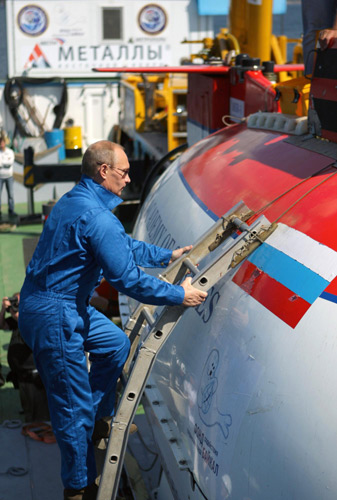Russian Prime Minister Vladimir Putin plunged into the depths of Lake Baikal aboard a mini-submersible on Saturday in a mission that adds a new dimension to his macho image.

|
|
Russia's Prime Minister Vladimir Putin climbs onboard of the "Mir-2" mini-submersible on which he intends to dive into the depths of Lake Baikal, August 1, 2009.[Chinadaily.com.cn via agencies]
|
Putin, a judo black belt who has flown in a fighter aircraft and shot a Siberian tiger in the wild, descended 1,400 metres (4,600 ft) below the surface of the world's deepest lake to inspect potentially valuable gas crystals.
"I haven't seen anything like that in my whole life. This is a very special feeling," Putin told reporters on emerging from the deep-sea craft looking pale and a bit dizzy after spending more than 4.5 hours underwater.
Asked if he planned to travel in space after his supersonic flight and deep-sea dive, Putin, dressed in blue overalls, said, "No, there is enough work here on earth."
Hidden on Lake Baikal's largely unexplored floor are large deposits of clathrate hydrate, crystals packed with one of Russia's most lucrative exports: natural gas.
Scientists estimate Baikal hydrates contain over 1 trillion cubic metres of natural gas, an amount comparable with the world's largest discovered gas fields. Mineral extraction is banned in Lake Baikal which is a nature reserve.
Before locking down the hatches on the Mir-2 submersible, Putin was shown specimens of crystals bubbling under water.
"You can touch it. There are very few people who have held hydrates in their hand, even fewer Baikal hydrates," Robert Nigmatullin, head of the Oceanology Institute, told the prime minister. "You can set it on fire as well, it will burn."
"Let's not set it on fire today," Putin said with a smile before entering the submersible, which then dived below the surface of the world's oldest lake.